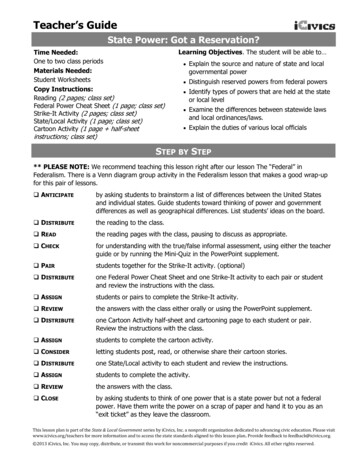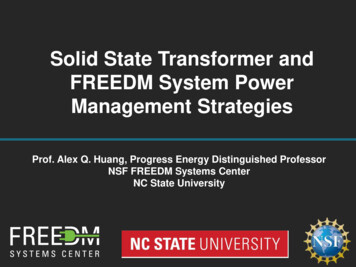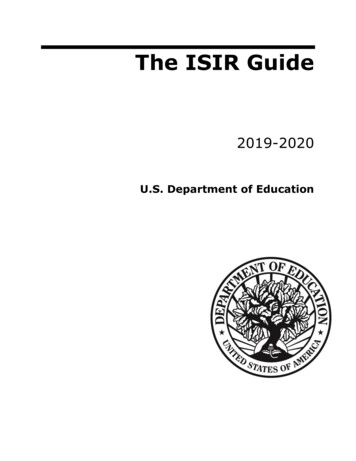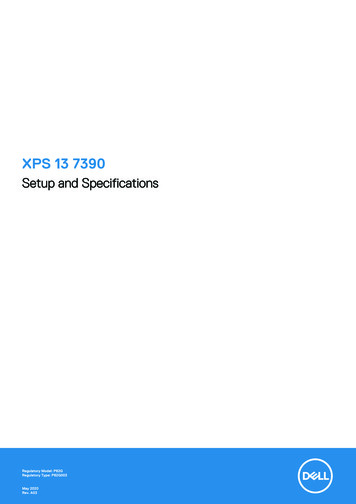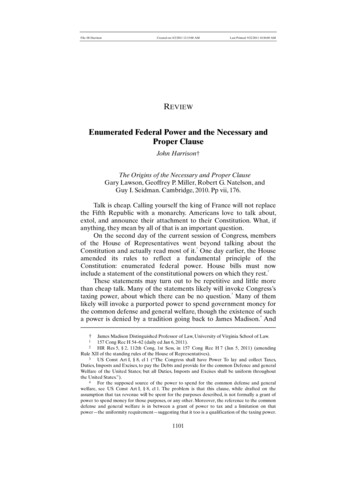
Transcription
File: 08 HarrisonCreated on: 8/2/2011 12:15:00 AMLast Printed: 9/22/2011 10:36:00 AMREVIEWEnumerated Federal Power and the Necessary andProper ClauseJohn Harrison†The Origins of the Necessary and Proper ClauseGary Lawson, Geoffrey P. Miller, Robert G. Natelson, andGuy I. Seidman. Cambridge, 2010. Pp vii, 176.Talk is cheap. Calling yourself the king of France will not replacethe Fifth Republic with a monarchy. Americans love to talk about,extol, and announce their attachment to their Constitution. What, ifanything, they mean by all of that is an important question.On the second day of the current session of Congress, membersof the House of Representatives went beyond talking about the1Constitution and actually read most of it. One day earlier, the Houseamended its rules to reflect a fundamental principle of theConstitution: enumerated federal power. House bills must now2include a statement of the constitutional powers on which they rest.These statements may turn out to be repetitive and little morethan cheap talk. Many of the statements likely will invoke Congress’s3taxing power, about which there can be no question. Many of themlikely will invoke a purported power to spend government money forthe common defense and general welfare, though the existence of such4a power is denied by a tradition going back to James Madison. And†James Madison Distinguished Professor of Law, University of Virginia School of Law.157 Cong Rec H 54–62 (daily ed Jan 6, 2011).2HR Res 5, § 2, 112th Cong, 1st Sess, in 157 Cong Rec H 7 (Jan 5, 2011) (amendingRule XII of the standing rules of the House of Representatives).3US Const Art I, § 8, cl 1 (“The Congress shall have Power To lay and collect Taxes,Duties, Imposts and Excises, to pay the Debts and provide for the common Defence and generalWelfare of the United States; but all Duties, Imposts and Excises shall be uniform throughoutthe United States.”).4For the supposed source of the power to spend for the common defense and generalwelfare, see US Const Art I, § 8, cl 1. The problem is that this clause, while drafted on theassumption that tax revenue will be spent for the purposes described, is not formally a grant ofpower to spend money for those purposes, or any other. Moreover, the reference to the commondefense and general welfare is in between a grant of power to tax and a limitation on thatpower—the uniformity requirement—suggesting that it too is a qualification of the taxing power.11101
File: 08 Harrison1102Created on: 8/2/2011 12:15:00 AMLast Printed: 9/22/2011 10:36:00 AMThe University of Chicago Law Review[78:1101many—probably most, possibly all—will invoke the Necessary andProper Clause of Article I, § 8. These statements raise the questionwhether much of the federal government’s substantive legislation isbased on an unduly broad reading of that clause and thereforeinconsistent with the Constitution.The Origins of the Necessary and Proper Clause casts new lighton that question. Part I of this Review is about the Necessary andProper Clause, briefly reviewing its central role in contemporaryfederal law and the recurring questions that arise in applying it. Part IIrecounts the book’s main arguments. Part III presents my views aboutthe soundness and implications of the inferences that the authorsdraw from their evidence. Some of those inferences are more securethan others, and those that are secure make an important contributionto understanding the clause. Part IV discusses the broader questionsof constitutional substance and interpretation that must be resolved inorder to determine whether claims about the original textual meaning,or textual meaning in any sense, matter for American constitutionalpractice.I. T HE NECESSARY AND PROPER CLAUSE: CURRENT USEAND CONTROVERSIESA. Congress’s Reliance on the Necessary and Proper ClauseThe Constitution is overwhelmingly about power, and it containsmany grants thereof to Congress, the President, the federal courts, anda few other recipients. Many of the powers of Congress areenumerated in Article I, § 8, which concludes with the Necessary andProper Clause. This clause gives Congress the power “to make allLaws which shall be necessary and proper for carrying into Executionthe foregoing Powers, and all other Powers vested by this Constitutionin the Government of the United States, or in any Department or5Officer thereof.”That the Necessary and Proper Clause has become a central6source of congressional authority is well known. For that reason I willnote only a few examples to illustrate the point. Probably the mostnoteworthy are the many statutes adopted on the basis of thecongressional power to regulate commerce among the several states,with foreign nations, and the Indian tribes, combined with theAn exposition of Madison’s position and of the subsequent debate appears in United States vButler, 297 US 1, 65–69 (1936).5US Const Art I, § 8, cl 18.6See Ronald D. Rotunda and John E. Nowak, 1 Treatise on Constitutional Law: Substanceand Procedure § 3.2(a) at 340–41 (West 3d ed 1999).
File: 08 Harrison2011]Created on: 8/2/2011 12:15:00 AMEnumerated Federal PowerLast Printed: 9/22/2011 10:36:00 AM1103Necessary and Proper Clause. A common indication that the latter isdoing much or almost all of the work is that the statutes apply toeconomic activity that is not commerce. The statutory sign of this is aninvocation of the regulated activity’s effect on commerce, which is abackhanded way of saying that the activity is not itself actuallycommerce. If the conduct in question were actually commerce, itwould not be necessary to have the added category of conduct thataffects commerce. But regulating the latter category goes beyond theregulation of commerce and so goes beyond the Commerce Clauseproper. Regulating conduct that is not commerce because it affectscommerce is legislating to carry into execution the power to regulatecommerce and so rests on the Necessary and Proper Clause, not theCommerce Clause strictly speaking.That is how the system of federal labor and employment law7operates. The National Labor Relations Act (NLRA), which createdthe system of collective bargaining overseen by the National LaborRelations Board (NLRB), rests on a congressional finding that refusalto bargain collectively leads to strikes, which burden and obstruct8interstate commerce. A similar rationale concerning effects oncommerce underlies major employment discrimination laws like the9Civil Rights Act of 1964 (CRA) and the Age Discrimination in10Employment Act (ADEA). Congress likewise regulates workplace11safety through the Occupational Safety and Health Act (OSHA) onthis basis, whether the workplace is one of commerce as opposed, for12example, to manufacturing.Although the commerce power is perhaps the most discussedprimary congressional power that is linked to the Necessary andProper Clause, it is of course not the only one. Indeed, it is quitepossible that every enumerated power on the list has some importantadjunct statute that is not based on a strict interpretation of that7Pub L No 74-198, 49 Stat 449 (1935), codified as amended at 29 USC § 151 et seq.See 29 USC § 151.9Pub L No 88-352, 78 Stat 241, codified at 42 USC § 2000e et seq. The employmentdiscrimination provisions of the CRA apply to employers in industries affecting commerce,42 USC § 2000e(b), which is a broader category than industries engaged in commerce.10 Pub L No 90-202, 81 Stat 602 (1967), codified at 29 USC § 621 et seq. The ADEA restson a congressional finding that age discrimination burdens commerce and the free flow of goodsin commerce. See 29 USC § 621(a)(4). As with the CRA, covered employers are defined as thosein industries affecting commerce. See 29 USC § 630(b).11 Pub L No 91-596, 84 Stat 1590 (1970), codified at 29 USC § 651 et seq.12 OSHA begins with a congressional finding that workplace injuries are a hindrance tointerstate commerce, see 29 USC § 651(a), followed by a statement of the purposes Congress ispursuing through the regulation of commerce. See 29 USC § 651(b). But working in amanufacturing facility is not, in general, commerce among the several states, although it mayaffect that commerce.8
File: 08 Harrison1104Created on: 8/2/2011 12:15:00 AMThe University of Chicago Law ReviewLast Printed: 9/22/2011 10:36:00 AM[78:1101power. The federal statute that governs voting by members of themilitary in presidential elections and requires that states provide them13with absentee ballots is one example. Ensuring military voting rightsis useful to raising an army but does not constitute doing so. Evenpowers not on the main Article I list are sometimes implemented thisway. The criminal ban on unauthorized use of the character SmokeyBear has its constitutional home in Congress’s power over federal real14estate in Article IV of the Constitution.To say that the Necessary and Proper Clause is routinely used isnot to say that anything strange is going on. Of course Congress canturn federal forests into national parks and allow camping. And ofcourse reminding campers to be careful with fire makes sense. Andpreserving Smokey Bear’s status as a national icon is an effectivemeans to this end. In contrast, the system of collective bargaining is amajor feature of American law, but its connection to the interstate saleof goods is not nearly as close as Smokey Bear’s connection topreventing forest fires. This is what makes the clause not onlyimportant, but problematic.B.Determining the Extent of the Clause’s ReachThe Necessary and Proper Clause is about means–endsconnections. It authorizes Congress to pass laws in order to dosomething. Usually, Congress is authorized to pursue some primarygoal by a provision of the Constitution other than the Necessary andProper Clause, frequently one of its other enumerated powers. Mostoften, this primary goal is to further the policy of some statute thatCongress is empowered to adopt. For example, Congress can establish15post offices, the purpose of which is to handle the mail. A statutemaking it a crime to set fire to a post office with the intent ofdestroying the mail would further that purpose and therefore would16be a means to the end of distributing the mail. I will refer to purposeslike the safe distribution of the mail as primary goals, and statutesadopted on the basis of the Necessary and Proper Clause as secondary13 The main statutory provision governing state responsibilities is 42 USC § 1973ff-1. I useits application to presidential elections as an example because Congress has separate powersover the times, places, and manner of elections for the House and the Senate, but presidentialelectors are to be chosen as determined by the state legislatures. Compare US Const Art I, § 4,cl 1; US Const Amend XVII, § 2, with US Const Art II, § 1, cl 4.14 See 18 USC § 711. As the statute sets out, Smokey Bear was created by the ForestService in the interest of preventing forest fires, especially in national forests.15 US Const Art I, § 8, cl 7.16 See 18 USC § 1705.
File: 08 Harrison2011]Created on: 8/2/2011 12:15:00 AMEnumerated Federal PowerLast Printed: 9/22/2011 10:36:00 AM110517rules. The main questions under the clause can be formulated in theseterms.Perhaps the first such question is this: How strong must themeans–end connection between the primary policy and the secondaryrule be? That question in turn breaks down into two sub-questions,which may be called the absolute and comparative versions. Theabsolute version asks how much the secondary rule will advance theprimary goal. The more the secondary rule contributes to achievingthe primary goal, the stronger the argument that it is authorized bythe clause. Thus, a statute punishing perjury in federal judicialproceedings pretty clearly makes a substantial contribution to thecourts’ factfinding function, an aspect of the judicial power that18supplies a purpose under the clause. In similar fashion, a requirementthat a large part of the population buy health coverage may well go along way toward keeping health insurance companies solvent whenthey are subject to requirements that cause them to take losses on19some of their contracts. By contrast, it is doubtful whether banningguns in the vicinity of schools would make a contribution to thequality of education so significant that it would also have an effect on20the country’s economic production.Relative or comparative instrumental contributions may alsomatter, depending on how one reads the clause. A secondary rule mayfurther the primary goal significantly, but there may be some othersecondary rule that would accomplish the same goal, as well as somereason to prefer one to the other. For example, forbidding setting fireto post offices and forbidding bringing combustible materials withinone hundred yards of a post office might be roughly equally effectivein protecting post offices from arson, but the latter has substantially17 By setting up the issues this way, I am suppressing many complexities. One that isimportant enough to note is whether one of Congress’s primary powers can itself supply apermissible goal, even if Congress has not exercised that power. A common ground for invokingthe necessary and proper power is Congress’s power to maintain the free flow of interstatecommerce. See, for example, NLRB v Jones & Laughlin Steel Corp, 301 US 1, 23 (1937)(justifying the NLRA on this basis). Certainly the commerce power enables Congress to regulateinterstate commerce per se for that purpose. It is doubtful, however, whether that purpose alonewill support action under the Necessary and Proper Clause if Congress has not enacted anyprimary legislation under the commerce power itself. Justice Antonin Scalia raised this point inGonzalez v Raich, 545 US 1 (2005). In that case, it was important to him that the regulation ofintrastate activity at issue was in support of a rule about strictly interstate commerce thatCongress in fact had adopted, not just one that it could adopt if it wanted to. See id at 37–42(Scalia concurring).18 See 18 USC § 1621; United States v Williams, 341 US 58, 68 (1951).19 See Patient Protection and Affordable Care Act § 1501(a), Pub L No 111-148,124 Stat 119 (2010). But see Florida v US Department of Health and Human Services,2011 WL 3519178, *66 (11th Cir).20 See United States v Lopez, 514 US 549, 561 (1995).
File: 08 Harrison1106Created on: 8/2/2011 12:15:00 AMThe University of Chicago Law ReviewLast Printed: 9/22/2011 10:36:00 AM[78:1101more collateral consequences for people’s conduct than does theformer. If those collateral consequences matter, then it will beimportant to compare secondary rules with one another.When government power depends on the reason for which thatpower is exercised, perhaps a distinction ought to be made betweenreal and pretextual reasons. It is one thing to say that a secondary rulewill further the primary goal but another to say that furthering thatgoal in fact led the legislature to adopt the secondary rule. Arequirement that the instrumental connection actually be Congress’sreason could impose substantial limits on its power under the clause.For example, the Supreme Court in NLRB v Jones & Laughlin Steel21Corp accepted the argument that more harmonious labor relations,achieved through collective bargaining overseen by the NLRB, would22reduce strikes and other disruptions of production. Reducingdisruptions, in turn, would enable interstate commerce to flow morefreely, an end the Court accepted under the Commerce Clause23proper. Whether that causal connection existed, it is easy to imaginethat the protection of interstate commerce alone would not have ledCongress to enact such a far-reaching statute. Rather, a belief that therules of labor law in the NLRA were more just than those of theexisting law of contracts may have been crucial in leading Congress topass the Act. If concerns about interstate commerce were not enoughto motivate Congress, then those concerns were in an important sensea pretext. The contention that a pretext does not satisfy the clause is atleast as old as Chief Justice John Marshall’s statement to that effect in24M’Culloch v Maryland.Another question concerning means and ends is whether sideeffects matter, and, if so, how. Here, a side effect is a consequence ofthe secondary rule other than its advancement of the primary goal.Common readings of the clause identify two particular kinds of sideeffects as potentially important. One is the expansion of federalpower. Venerable readings of the clause hold that secondary rulesmust not expand congressional authority too much, even if theyadvance primary goals to an otherwise acceptable extent. One suchconstraint is the requirement that the clause not completely overturn21301 US 1 (1937).Id at 42.23 Id at 41.24 17 US (4 Wheat) 316, 423 (1819) (“[S]hould Congress, under the pretext of executing itspowers, pass laws for the accomplishment of objects not entrusted to the government; it wouldbecome the painful duty of this tribunal, should a case requiring such a decision come before it,to say that such an act was not the law of the land.”).22
File: 08 Harrison2011]Created on: 8/2/2011 12:15:00 AMEnumerated Federal PowerLast Printed: 9/22/2011 10:36:00 AM110725the principle of enumerated—and hence limited—federal power.That consideration very likely drove the Court’s attempt in United26States v Lopez to develop formal principles, which in that casecentered on the distinction between the economic and thenoneconomic, that would keep Congress from possessing plenary27legislative authority because of the clause.A more elaborate version of this principle is as old as the debateitself. Criticizing the legislation creating the First Bank of the UnitedStates, James Madison argued that there is a difference in principlebetween incidental powers, which can come through the Necessaryand Proper Clause, and “independent and substantive” powers, which28cannot. Madison maintained that chartering a banking corporationwas an example of the latter, because the power to create corporations29was such an important aspect of the sovereign prerogative. He wasalso clear that if a power were independent and substantive, aninstrumental connection with a permitted primary goal was not30enough: neither implication nor the clause could supply such powers.According to some readings, then, if a secondary rule has theeffect of unduly expanding federal power in general, or of exercising aparticular category of power, it may be beyond the clause, even if itfurthers a permissible goal. Hence, other effects matter insofar as theyconsist of greater congressional authority.The second category of side effects that is often thoughtproblematic covers consequences for individual rights, meaningspecified individual interests or legal advantages. Some readings of theclause hold that a secondary rule is impermissible, without regard toits instrumental value, if it interferes with particular choices or actions,31such as decisions that are important exercises of autonomy. Speechand religion are natural examples, but it is important to see that thisprinciple may extend to other choices, so that such a limited view ofthe necessary and proper power would not be redundant of theaffirmative limitations (not all of which were in place when the clausewas adopted). Decisions regarding healthcare may fall into this25See A.L.A. Schechter Poultry Corp v United States, 295 US 495, 529–30 (1935).514 US 549 (1995).27 See id at 560–61.28 James Madison, The Bank Bill (Feb 2, 1791), in Charles F. Hobson, et al, eds, 13 ThePapers of James Madison 372, 375–79 (Virginia 1981).29 See id at 378.30 See id at 379.31 A leading discussion of this possibility was coauthored by one of the book’s authors,Gary Lawson. See Gary Lawson and Patricia B. Granger, The “Proper” Scope of Federal Power:A Jurisdictional Interpretation of the Sweeping Clause, 43 Duke L J 267, 326–31 (1993).26
File: 08 Harrison1108Created on: 8/2/2011 12:15:00 AMThe University of Chicago Law ReviewLast Printed: 9/22/2011 10:36:00 AM[78:1101category, and they are not as such protected by any of the specificenactments in favor of liberty of conduct.None of the foregoing questions takes into account the institutionalstructure of the government and the different perspectives of differentdecisionmakers. Those perspectives raise another set of importantquestions. Judgments about instrumental connections and other effectsare generally predictive questions of fact, and not questions of law. Yet,a legal norm means that the extent of congressional power depends inpart on these judgments of fact, and so in some way brings them withinthe purview of legal analysis.This fact about the clause then must be taken into account in alegal system in which governmental institutions other than thelegislature address constitutional questions. In particular, it must betaken into account during judicial review, in which courts assess theconformity of congressional statutes with the Constitution, on theassumption that if the former do not square with the latter, then theyare to be disregarded as invalid. Judicial review is premised on theassumption that, to a large extent, courts will decide constitutionalissues for themselves, and in particular that they are not absolutely32bound by any conclusions reached by Congress while legislating. Butwhile some degree of judicial independence is fundamental to judicialreview, judges and commentators have seriously considered thepossibility of some deference to the legislature since judicial review33was first practiced in this country.It is unsurprising, then, that one standard candidate for a categoryof legislative judgments to which courts should defer in constitutionalcases is that of the instrumental judgments that must be made under32 See Marbury v Madison, 5 US (1 Cranch) 137, 177 (1803). See also City of Boerne vFlores, 521 US 507, 519–24 (1997).33 See, for example, United Haulers Association, Inc v Oneida-Herkimer Solid WasteManagement Authority, 550 US 330, 349 (2007) (Scalia concurring) (“Generally speaking, thebalancing of various values is left to Congress—which is precisely what the Commerce Clause(the real Commerce Clause) envisions.”); Whitman v American Trucking Associations,531 US 457, 474–75 (2001) (“In short, we have almost never felt qualified to second-guessCongress regarding the permissible degree of policy judgment that can be left to those executingor applying the law.”) (quotation marks omitted); Chevron, U.S.A., Inc v Natural ResourcesDefense Council, Inc, 467 US 837, 843 (1984) (“If the intent of Congress is clear, that is the end ofthe matter; for the court, as well as the agency, must give effect to the unambiguously expressedintent of Congress.”). See also Felix Frankfurter, John Marshall and the Judicial Function,69 Harv L Rev 217, 228–38 (1955). The argument that courts should give strong deference tolegislatures in deciding constitutional questions under American constitutions is older than theConstitution itself, having been raised, for example, by St. George Tucker while arguing a 1782case involving an attack on the constitutionality of a Virginia treason statute under Virginia law.See William Michael Treanor, The Case of the Prisoners and the Origins of Judicial Review,143 U Pa L Rev 491, 527 (1994) (noting that Tucker believed a statute had to be “dramatically atodds with the constitution” for it to be unconstitutional).
File: 08 HarrisonCreated on: 8/2/2011 12:15:00 AM2011]Last Printed: 9/22/2011 10:36:00 AMEnumerated Federal Power110934the clause. Considerations of comparative expertise may weigh infavor of deference here. For example, Congress’s job is to make policyand, to effectively do so, it must develop the ability to predict theprobable consequences of various possible legislative measures.Courts may have a hard time, for example, determining whether thescale of federal borrowing calls for a national bank. Senators andrepresentatives with substantial experience in federal finance, bycontrast, may be in a very good position to answer that question. But aconstitutional system that places court-enforced limits on legislativepower is unlikely to have the judiciary defer completely to thelegislature even on factual questions, because to do so wouldsubstantially take back the decision to limit the legislature with rulesenforced in part through the courts. The appropriate degree ofdeference has become another important question in the applicationof the clause, because with a provision that is fundamentally aboutfactual questions of means and ends, deference on policy and factualjudgments can have an effect that is practically very similar to anexpansion of federal power.II. THE LEGAL BACKGROUND OF THE NECESSARYAND PROPER CLAUSEEven those who disagree about the exact significance of theConstitution’s history generally agree that it is important. That historyincludes not only the document’s framing and ratification but also thebackground of its concepts and institutions. To understand the judicialpower conferred by Article III, it is common to look to the practices35of the English courts that were known to the Framers. It is also astandard, though controversial, move to look to the King’s authority inunderstanding the President’s authority, and specifically in36understanding the executive power referred to in Article II.It may be surprising, then, that the historical antecedents of theNecessary and Proper Clause have not been much investigated,despite that clause’s centrality. To explain that gap, one might theorize34 See Lopez, 514 US at 616 (Breyer dissenting) (“Courts must give Congress a degree ofleeway in determining the existence of a significant factual connection between the regulatedactivity and interstate commerce.”).35 See, for example, Coleman v Miller, 307 US 433, 460 (1939) (Frankfurter dissenting)(“Judicial power [under Article III] could come into play only in matters that were thetraditional concern of the courts at Westminster and only if they arose in ways that to the expertfeel of lawyers constituted ‘Cases’ or ‘Controversies.’”).36 A leading example is Saikrishna B. Prakash and Michael D. Ramsey, The ExecutivePower over Foreign Affairs, 111 Yale L J 231, 265–72 (2001).
File: 08 Harrison1110Created on: 8/2/2011 12:15:00 AMThe University of Chicago Law ReviewLast Printed: 9/22/2011 10:36:00 AM[78:110137that the clause’s great expansion from the 1930s to the 1960scoincided with a lack of interest in history among judges andcommentators. But the clause has been a constitutional crux since thevery beginning, and courts and scholars hardly ignored history whilethe clause’s role was growing. A more likely, or at least partial,explanation is that the clause has no obvious antecedents because thegovernmental structure in which it operates has no obviousantecedents. The Federal Convention largely invented constitutionalfederalism, the accompanying principle of limited federal power, andthe particular implementation of that principle through a specificenumeration of authority. As the clause is one further piece in thatlarger and largely novel system, one might think that it has nohistorical sources in any interesting respect.One would be wrong. The authors’ large claim is that theterminology of the Necessary and Proper Clause, and the conceptsthat have become familiar in interpreting it, have proximate roots inthree bodies of eighteenth century Anglo-American law (pp 4–8).They do not assert that the specific words of the clause had a wellunderstood and reasonably determinate legal meaning, but they dosay that the arrangement the Constitution establishes through thosewords is quite similar to other legal arrangements that were wellknown to the framers and other legally sophisticated Americans oftheir time (pp 4–5). These arrangements are the private law offiduciaries, the public law of subordinate governmental bodies, and thecombined public and private law of corporations (p 8). In all of thesecontexts, they say, it was common to invest someone with particularauthority and then with further power to exercise the primaryauthority, where the contours of the further power were not specified.These contours were, however, often identified by the words“necessary and proper” and their cognates and relatives. This aspect ofthese bodies of law, they say, is the Necessary and Proper Clause’simmediate historical source (pp 4–8).A. Fiduciary LawChapters 4 and 5, principally the work of Professor RobertNatelson, trace the affinities between the private law of fiduciaries—and specifically grants of power to fiduciaries to act for theirprincipals—and the Constitution. Professor Natelson argues that it isnatural to see such connections, because the Framers, following a longline of tradition, regarded governmental authorities as trustees or37 See Stephen Gardbaum, Rethinking Constitutional Federalism, 74 Tex L Rev 795,807–08 (1996).
File: 08 Harrison2011]Created on: 8/2/2011 12:15:00 AMEnumerated Federal PowerLast Printed: 9/22/2011 10:36:00 AM1111fiduciaries or otherwise acting on behalf of the people (pp 52–57). Hethen takes up and treats at length the feature of the private law mostrelevant to the clause: a distinction between principal and incidentalgrants. The general principle, applicable but not limited to grants ofauthority, was that giving the principal brought with it the incidental.For example, a conveyance of a parcel of land could implicitly bringwith it another real-property interest required to make the conveyedinterest useful, so that a lord of the manor granting land was assumedto give along with it the right to graze livestock on the lord’s unfencedpasture (p 64).In general, Natelson says, when a principal right or power wasgiven, incidental rights or powers came with it automatically by legalimplication. But not everyone would know about that implication, so38some drafter
Gary Lawson, Geoffrey P. Miller, Robert G. Natelson, and Guy I. Seidman. Cambridge, 2010. Pp vii, 176. . 2 HR Res 5, § 2, 112th Cong, 1st Sess, in 157 Cong Rec H 7 (Jan 5, 2011) (amending . the system of collective bargaining overseen by the National Labor Relations Board (NLRB), rests on a congressional finding that refusal .





